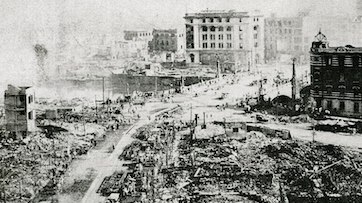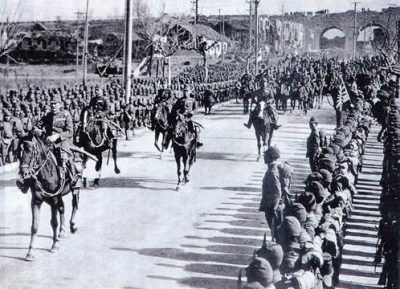Great Kanto Earthquake in 1923 and the Killing of Koreans and Socialists (A Mirror of Global Evil)
Kanako Mita, Sawako Utsumi, and Lee Jay Walker
Modern Tokyo Times

The Great Kantō Earthquake of 1923 was one of the most catastrophic disasters in modern Japanese history. In a matter of minutes, more than 100,000 lives were lost — some estimates place the final toll at as high as 142,000. Tokyo and Yokohama, the heart of Japan’s urban modernity, were transformed into vast fields of rubble and flame. Entire neighborhoods vanished beneath collapsing buildings and firestorms driven by typhoon-like winds.
Even without the horrors that followed — the ethnic massacres and political purges — the earthquake itself was a national cataclysm, a convulsion so violent it seemed to tear apart not only the earth but the fragile fabric of Japanese society. Streets split open, rivers boiled with debris, and the air filled with the stench of smoke and ash. The physical devastation alone was apocalyptic, leaving survivors in shock and the nation reeling at the scale of its ruin.
The deaths of ordinary people were shockingly high. Yet, as if the natural disaster itself were not cruel enough, the tragedy deepened in the days that followed. Amid the ruins, rumors and fear gave rise to murderous hysteria. Thousands of Koreans — along with Chinese residents and even some Japanese mistaken for them — were slaughtered by vigilantes, police, and soldiers. This eruption of violence revealed something far darker than the quake’s physical destruction: a nationalist psyche steeped in suspicion, hierarchy, and racial superiority.
What began as panic soon hardened into a pattern — a logic of exclusion and dehumanization that would later resurface with terrifying force. The same impulses that justified the killings of Koreans in 1923 would echo across Asia during the Pacific War, in the massacres of Chinese, Southeast Asians, and other peoples under Japanese imperial expansion. The Great Kantō Earthquake thus became not only a natural calamity but also a grim foreshadowing of the moral earthquakes to come.
It should be remembered that this was a profoundly dark period in human history. Barely a decade earlier, Europe had torn itself apart in the slaughter of World War I, where millions perished amid trenches, artillery fire, and the poison clouds of mustard gas. Across Anatolia, the dying Ottoman Empire turned upon its own, as nearly two million Christians — Armenians, Assyrians, and Pontic Greeks — were massacred by Turkish Muslims (Kurdish Muslims also killed many Christians) or driven into the desert. Elsewhere, Arab and Ottoman slave systems still trafficked in human lives, while the Western imperial powers brutalized and exploited countless peoples across Asia, Africa, and the Pacific.
The early twentieth century was thus a world steeped in violence, conquest, and racial hierarchy, where the suffering of others was often accepted as the price of order or progress. This, of course, in no way justifies the barbarity unleashed against Koreans after the Great Kantō Earthquake of 1923, but it does remind us of the wider moral climate of the age — an era chillingly indifferent to human life when measured against the lines of race, faith, or empire.
Anti-Korean sentiment had long existed before the earthquake, rooted in years of colonial domination and racial hierarchy. When the Great Kantō Earthquake struck, this latent hostility ignited with deadly speed. In the first chaotic hours after the disaster, mobs began attacking Korean residents based on wild rumors — and elements within the state apparatus not only failed to stop the violence but quietly encouraged it, once they saw how swiftly the mobs turned their fury on a convenient “enemy.”
As the bloodletting spread, the logic of repression widened. Accordingly, Japanese trade unionists, socialists, and anarchists — already watched with suspicion by police and the military — were also swept up in the chaos.
Some were executed outright, others disappeared without record. The earthquake had cracked not only the land but the fragile bonds of civil society, and in the convulsions that followed, ethnic hatred and political persecution merged. While the government struggled to respond to the overwhelming physical devastation, it also used the crisis as cover to silence dissent, blurring the line between maintaining order and enforcing ideology.

The massacres of Koreans in 1923 were not an isolated tragedy, but rather a grim foreshadowing of the atrocities that would later accompany Japan’s march toward empire. The same forces of racial arrogance and moral desensitization that erupted in the chaos of the Great Kantō Earthquake would, a decade later, culminate in the Rape of Nanjing, where Chinese civilians were slaughtered on an even greater scale.
Equally, the violent hatred of socialism and trade unionism within Japan found its dark reflection abroad — in the Soviet Union, where Communist purges devoured millions of non-Communists in the name of ideological purity. The events of 1923 thus stand as a microcosm of a world steeped in brutality and division, a world still dominated by empires, Arab Muslim slave systems against Africans, and vast political and racial hierarchies.
The same century that saw the Turkish extermination of Armenians, Assyrians, and Pontic Greeks in 1915 would also give rise to the Japanese massacre at Nanjing and, ultimately, to the Nazi Holocaust, which sought the annihilation of Jews, Roma, and others deemed “unworthy of life.”
In this context, the Great Kantō Earthquake was not only a natural disaster — it was a mirror to humanity’s capacity for cruelty, reflecting a planet convulsed by fear, ideology, and the relentless urge to dominate the Other.

Modern Tokyo News is part of the Modern Tokyo Times group
http://moderntokyotimes.com Modern Tokyo Times – International News and Japan News
http://sawakoart.com – Sawako Utsumi’s website and Modern Tokyo Times artist
https://moderntokyonews.com Modern Tokyo News – Tokyo News and International News
PLEASE JOIN ON TWITTER
https://twitter.com/MTT_News Modern Tokyo Times
PLEASE JOIN ON FACEBOOK